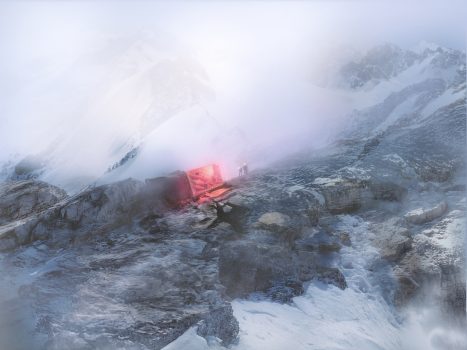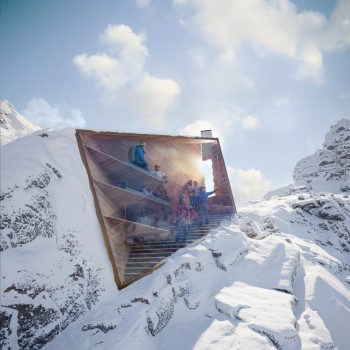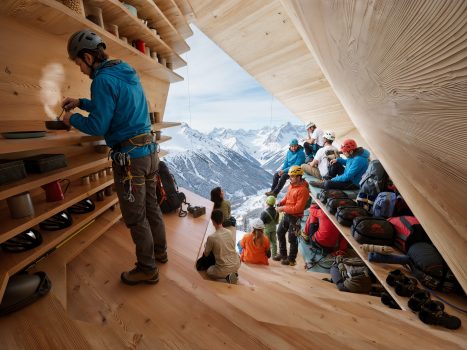CRA-Carlo Ratti Associati, in collaboration with Salone del Mobile.Milano, unveils a new digitally fabricated bivouac that harmonizes with the Alpine landscape. The process begins with a 3D scan of rock formations in the Alps. The resulting design minimizes visual impact while maximizing functionality – incorporating energy production, storage, and water harvesting through air condensation. Set to debut as an urban pavilion during the 2026 Winter Olympics in Milan, the shelter will then be airlifted to its permanent location in the Alps, where it will serve as a lasting refuge for mountaineers.
CRA’s approach to the design seeks to dissolve the boundary between nature and human-made structures. By digitally scanning alpine rock formations, the team created a precise 3D model of the landscape, which informed the shelter’s design. The result is a shell structure made of cross-laminated timber (CLT), aerogel, and metal that is inspired by the crystalline formations of the Alps and blends with the shape of its surroundings.
Designed to be completely self-sufficient, the bivouac features a 5KW peak photovoltaic system with storage, providing power for all its energy needs, including network connectivity. In an area with no access to natural water sources, the bivouac utilizes an air condensation system to produce several liters of potable water per day, ensuring climbers and trekkers always have access to clean water, even in emergencies. Unlike traditional bivouacs, which are painted in bright colors to ensure visibility in foggy or cloudy weather, the shelter employs a more subtle approach, blending into the landscape. Instead, a bright red light will activate only in conditions of limited visibility, reducing its visual impact while still ensuring safety in critical moments.
The glass wall of the bivouac offers a meditative view of the surrounding Alps. Beyond its function as a shelter, the structure provides a temporary sanctuary—a place for reflection, rest, and connection to nature.
The bivouac will have a dual existence. Initially, it will be showcased as a temporary pavilion coinciding with the 2026 Winter Olympics, to celebrate alpine culture. After the event, it will be airlifted by helicopter to its final permanent site at high altitude, where it will continue to serve climbers for generations to come. This two-phase lifecycle embodies the deeper principles of circular design, with the structure bridging urban culture and mountain heritage in a sustainable, lasting way.
“Unfortunately, today bivouacs often look like airships that have landed on our beautiful alpine landscapes. Here we took the opposite approach: a structure that blends as much as possible with the surroundings,” said Carlo Ratti, professor at MIT and the Politecnico di Milano, co-founder of CRA, and director of the Biennale Architettura 2025. “Great 20th-century Italian architect Gio Ponti once said that architecture is ‘like a crystal’. We took that literally in this design, using digital fabrication to design a bivouac as if it were part of the natural rock formations that shape the Alps.”
“For the Salone, the bivouac by CRA-Carlo Ratti Associati conveys a vision of design we share: one capable of blending landscape, innovation, and respect. It speaks of a future in which architecture does not impose itself but adapts, observes, and enters into dialogue with the environment, highlighting our material of choice—wood—as an emblem of conversation with nature. It is a gesture that turns research into a form of harmony with the natural world and that, in its journey from our Milan to the Alps, expresses the principles we share: a circular, responsible design,” stated Maria Porro, President of Salone del Mobile.Milano.
The bivouac is the latest in a series of key projects from CRA that blend the natural and artificial world. Previous works include the studio’s award-winning Olympic torches for the Milano Cortina 2026 games, as well as the recently unveiled AquaPraça in Venice, a centerpiece of the Italian Pavilion at COP30. Through projects like the Alpine bivouac, CRA reaffirms its commitment to creating architecture that works with nature, not against it.
CREDITS
Design: CRA-Carlo Ratti Associati
A collaboration with Salone del Mobile.Milano
ABOUT CRA-CARLO RATTI ASSOCIATI
CRA-Carlo Ratti Associati is an international design and innovation practice based in Turin, Italy, and New York City. Drawing on Carlo Ratti’s research at the Massachusetts Institute of Technology (MIT), the office is currently involved in many projects across the globe, embracing every scale of intervention – from furniture to urban planning. Among recent projects are the Italian Pavilion at Expo 2020 Dubai, the biophilic skyscraper CapitaSpring in Singapore, the urban curatorship of Manifesta 14 Prishtina biennial, the redesign of the Agnelli Foundation headquarters in Turin, and the master plan for the Milan Innovation District (MIND). CRA is the only design firm whose work has been featured three times in TIME Magazine’s “Best Inventions of the Year” list – with the Digital Water Pavilion, the Copenhagen Wheel, and Scribit. Carlo Ratti is the appointed Curator of the 19th International Architecture Exhibition of La Biennale di Venezia (2025).
ABOUT SALONE DEL MOBILE.MILANO
The Salone del Mobile.Milano has been an international benchmark for the design and furnishing world since 1961, thanks to the extraordinarily high quality of the products on exhibit. It is more than a trade fair, rather an ecosystem with the power to accelerate business and broaden relationships throughout the industry, proffering new visions of the future of living. It takes place in April and consists of four annual exhibitions – the Salone Internazionale del Mobile, S.Project, Workplace3.0 and the International Furnishing Accessories Exhibition – with alternating biennial exhibitions: Euroluce in odd years and EuroCucina with FTK/Technology For the Kitchen and the International Bathroom Exhibition in even years. These have been accompanied by SaloneSatellite since 1998, a launchpad for young designers under 35 from all over the world – so far more than 14,000 of them have passed through its doors – and a point of reference for companies on the look-out for new talents. About 2,000 exhibitors took part in the 63rd edition of the Salone del Mobile.Milano in April, with an overall influx of more than 302,000 attendees, with the highest-ever share of foreign professionals (68% of attendees). The Salone del Mobile is ISO 20121 certified for sustainable event management and is a member of the United Nations Global Compact.
www.salonemilano.it/en






